My presentation at the Nuffield conference is now online. 2 years work in 12 minutes
My presentation at the Nuffield conference is now online. 2 years work in 12 minutes
All my travels, experiences and hard work have been published on the Nuffield Website. I hope you enjoy it and please share with people who you think may enjoy it
Many thanks
This was my last visit on my foreign part of my Nuffield travels. I have one more visit in the UK planned and then I need to knuckle down to write my report. Jacob had the honour of being my last foreign visit. Jacob is an American who has worked all around the world but has now settled in Denmark. He has done work on intercropping and companion planting. Recently he has been working in China ( more research money there). His colleagues in China have had great results with intercropping and got very large yield increases. They have poor Loess soils and this is why he thinks they get advantages through intercropping. Jacob not so sure in the West we will see the large yield increases but we will see many other advantages especially of lowering inputs and safeguarding the environment.
Recently Jacob has been working on the OSCAR project which is a European wide research project into cover cropping and intercropping: http://web3.wzw.tum.de/oscar/index.php?id=2
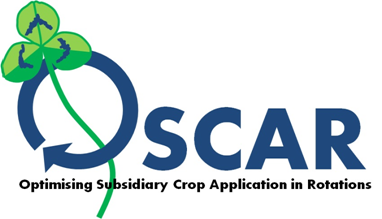
Jacob was specifically looking at the use of Subterreanean Clover in cereals in the Mediterranean. Sub-clover is very interesting as it is low growing and seeds underground. Ideal as a companion. The problem is it is difficult to establish and needs water otherwise it competes too much with the main crop. Also we need new varieties which are suited better to the UK climate.
The other research Jacob has been doing is looking into seeding patterns and its effects on weeds. This work is the reason I contacted him as I saw a feature in “The Furrow” magazine. Jacob has been looking at inter row spacing and intra row spacing. Ideally the distances want to be 45mm for both. This means the need for more precise seeding technology and also a doubling of seed rates. He has had some great results. In the trials they planted their weed (WOSR) and did different seed rates and seeding patterns. The results can be seen below:

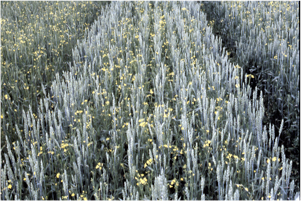
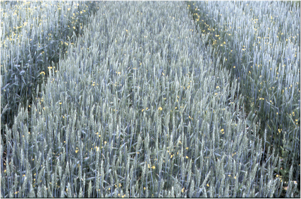
He has got 72% weed control from both high seed rates and uniform seeding. The uniform seeding alone gave an 30% advantage in weed control.
The final idea we discussed was “evolutionary theory in agriculture “. Basically evolution is not necessarily the best thing for agriculture. In a field of wheat for example you don’t necessarily want the best yielding individual plants as they can disadvantage their neighbours, you want the plants that work best as a community. You want the best yield per hectare not yield per plant. This goes against most thinking in plant breeding and is not a popular idea with his peers. It also has repercussions for varietal mixtures and intercropping. The best varities for intercropping will not necessarily be the highest yielding, they need to be social plant. Also this theory applies to managing varietal mixtures. You do not want to leave them to evolve to selfish individuals. You want to add new genetics to stop the gene pool of the mixtures narrowing.
After seeing Jacob we went to the Inaugural lecture of a new professor here looking at biological time machines

The proffesor was working on climate change. The was trying to look into the future effects of changing temperatures, rainfall and CO2 through outdoor experiments to try to predict the ecosystem effects of climate change into the future and the effects on plant communities. He was saying it is hard to work with a multi factorial, outdoor environment which is changes each year, he should try FARMING!
After the lecture we had a free lunch and drinks reception and then my last foreign visit was over. I have had an amazing time on my travels and learnt so much. The best things has been meeting new contacts and making new friends which is invaluable. Anyone thinking of applying for a Nuffield Scholarship “just do it!”
Soren Ilsoe is a well known Conservation Agriculture practitioner in Denmark and was Green Farmer of the Year in 2013

No till, covering cropping and Conservation Ag are not common at all in Denmark and Soren has been at the forefront of Danish CA for a long time.
Denmark has very strict regulations on fertiliser and pesticide use. Up until this year the cap on Nitrogen fertiliser applications has been 20% below the economic optimum. The government changed last year and so that cap was raised by 12% this year and will rise by another 8% next year. Soren thinks if the government changes back to the left again they will reverse these changes immediately. Denmark also has its own pesticide approval system which is slower and more onerous than the EU system, hard to believe it could be slower! Also Denmark applies pesticide taxes making some products almost uneconomical .
Soren is involved in a new project with the University of Copenhagen where they will compare plough, min till and no till on his farm and two neighbours. They will measure all parameters from economic, soil, biological etc.
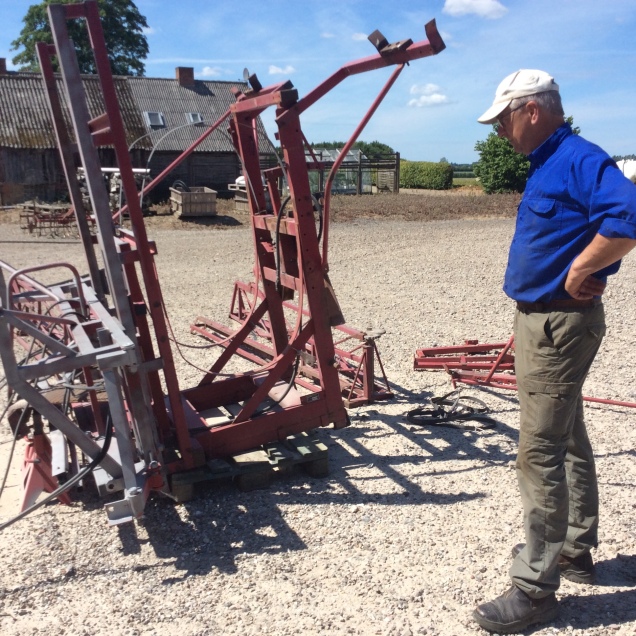
When I arrived Soren was building a cover crop seeder from an old mounted sprayer. The idea is to broadcast cover crops into standing crops to allow for more growth. Harvests can be late here this far north and getting a cover crop in after harvest can be challenging.
Soren uses a modified Horsch CO4

He can apply starter fertiliser with this machine which he believes is extremely important, especially with the Nitrogen restrictions. 80kg/ha/N placed is worth 100kg broadcast. On the back of this machine he can apply slug pellets and he also hopes to add a small seed kit in front of the wheels to apply companion seeds for WOSR
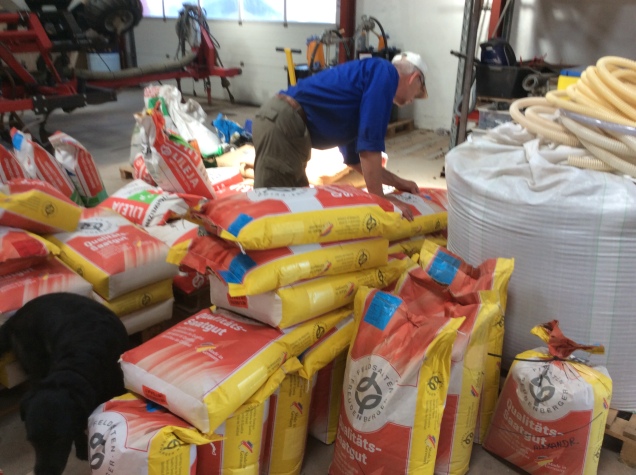
Soren mixes his own cover crop seed and includes different clovers, vetch, buckwheat, Phacelia, radish and peas.
The first field of wheat we went into had received no autumn herbicide

He has trials in this field where he has used different herbicide rates. The only difference was a few cleavers in the no herbicide parts from what I could see. In the same field he had no fungicide areas too. This will be weighed to see if there is a yield difference. The field currently looked very clean. On another field BASF, Bayer and Syngenta have parts of the field they are treating themselves to try to get optimum yield. Soren believes in using lower inputs and accepting an average yield as in most years he makes more money than those chasing yield. I agree with him. It will be interesting to see if the suppliers field areas margin is any better or worse than Soren’s, doubtful.

Soren normally doesn’t grow second year wheat but has this year. He has used RTK and planted the crop inbetween the stubble of last years so the wheat was planted into clean soil
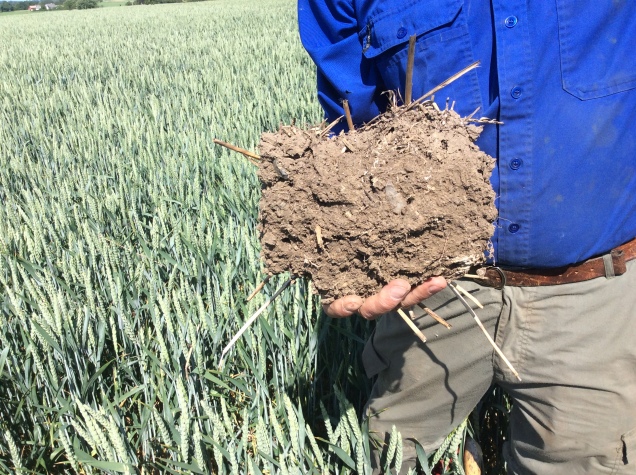
Soren’s was in very good nick, very dry too! He has lots of worm holes and around the worms holes it was clear to see chalk. The worms we bringing up chalk from deep and liming his fields for him, for free!
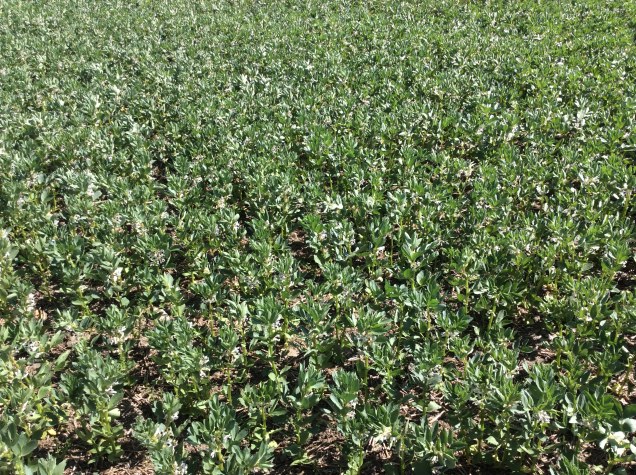
We then looked at his spring beans. Most of the fields had had no herbicide either, there were a few weeds but nothing much. Rats tail Fescue is the Black Grass equivalent here but Soren seems to be keeping on top of it through mainly good rotation.

His beans had good roots and nodulation.
The last crop we looked at was his Spring barley
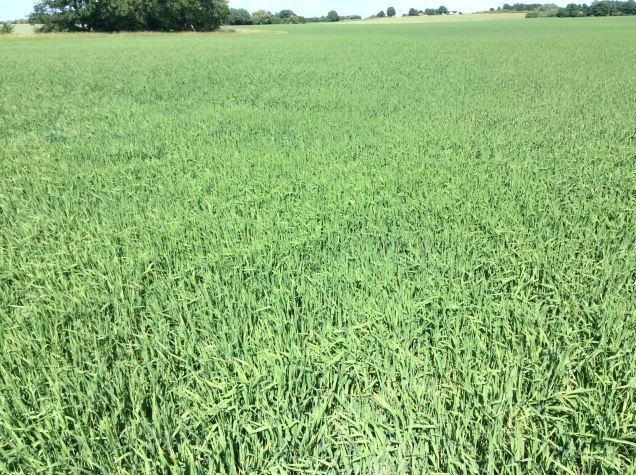
This was planted on the 16th of April which is later than normal. Also later than his conventional neighbours. Soren was worried it was a bit thin but I thought it looked well. The combine will tell. Soren shares a combine with a conventional neighbour so he can compare.
I had an interesting afternoon with Soren. His farm seemed a little like mine at home with different trials everywhere. Thank you for your time Soren.
After seeing the crops at Josef and Joel that had been planted using the System Cameleon, I decided to go and meet the company themselves and so drove 4 hours north.

The company Gothia Redskap is owned and run by the Askling family with Lars Askling at the helm. Lars is a second generation farmer as his father started farming in the area in the mid seventies. He started farming biodynamically and today the farm is still organic. It is now a group of three organic farmers working together covering 800ha.
My day started with a tour of the factory with Johan Hedestad
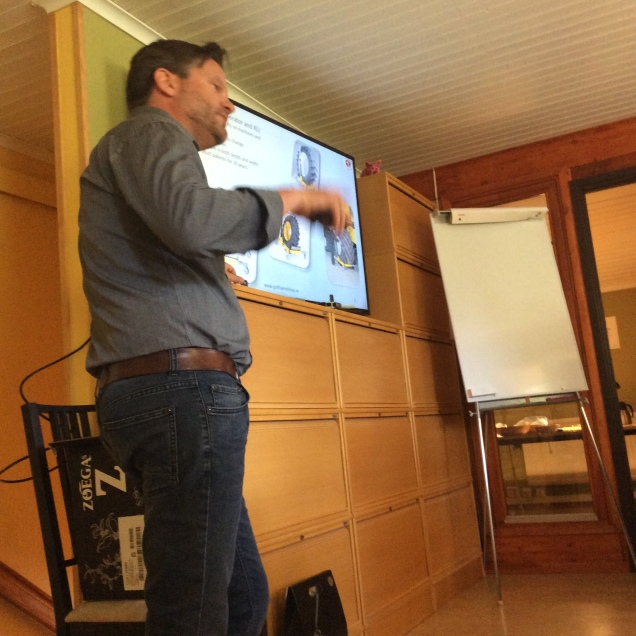
Johan was my guide for the day and kindly organised everything for me. He has started working for the company fairly recently to help with the fast expansion that is happening at Gothia Redskap. Not only do they build the System Cameleon but also wheel lifters for removing large tyres
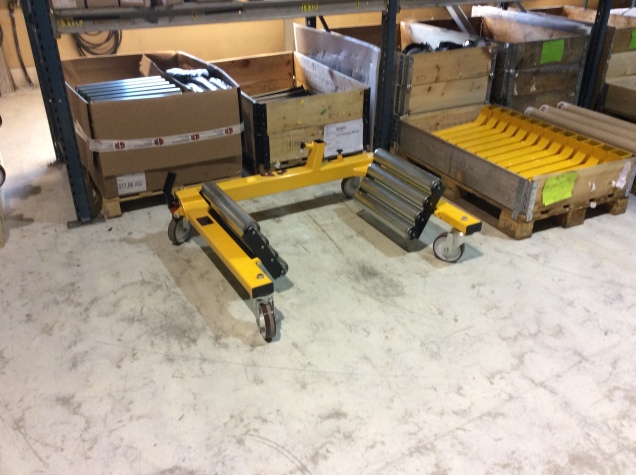
They had a patent for these for 18 years. Once the patent lapsed the Chinese copied it and sold it for half the price and Gothia’s sales halved. The copies though fell apart and so people are returning to the quality Swedish Product. We have one at home but I think it may be one of the cheap copies, so hopefully it won’t fall apart with a combine tyre inside!
Their main manufacturing is of the System Cameleon which is a seeder, inter row hoe and fertiliser application tool all in one. Lars built one for himself in around 2009 as he had problems with thistles and no tool available to deal with them. Then he sold the first one in around 2010 and now this year so far they have sold twenty and their goal is to sell 80 per year by 2020. A hundred machines in total have been sold. This will mean they will need to expand their factory and plans are underway. At the moment there are three sections to the build. First they put the frame together
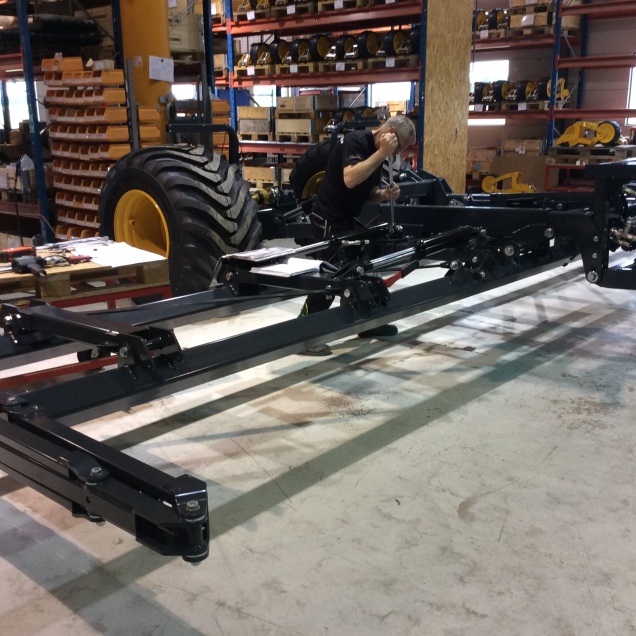
Then they add the electric and hydraulics etc.
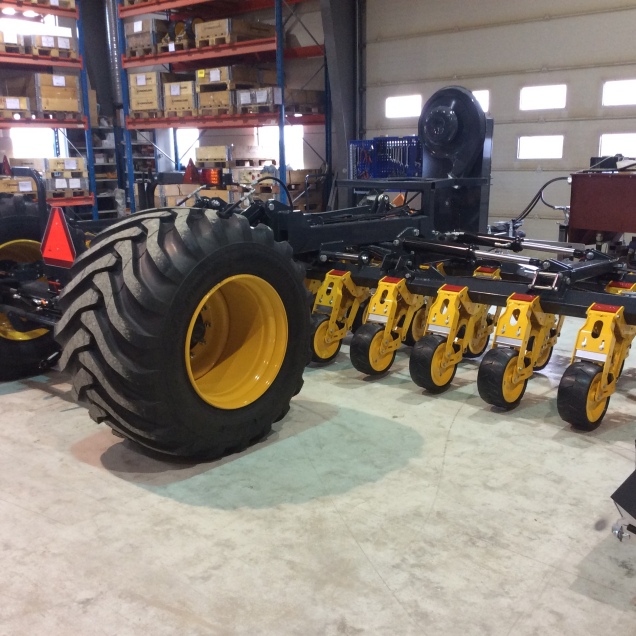
Then you get the finished product
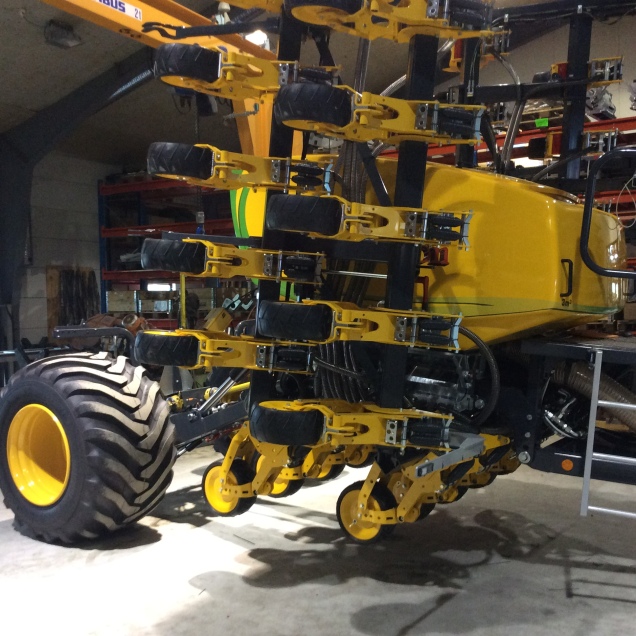
After the factory tour I went out to a field with Lars’s son “to pretend” to hoe a crop
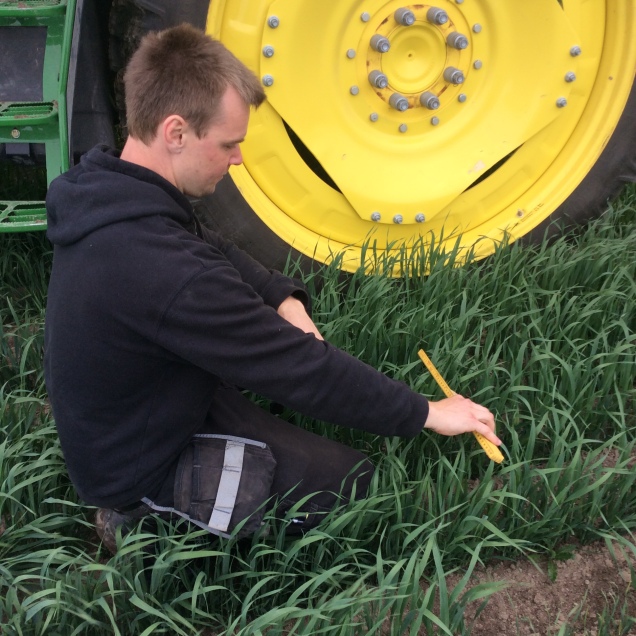
You have to measure the crop so you can calibrate the camera on the machine so it hoes accurately
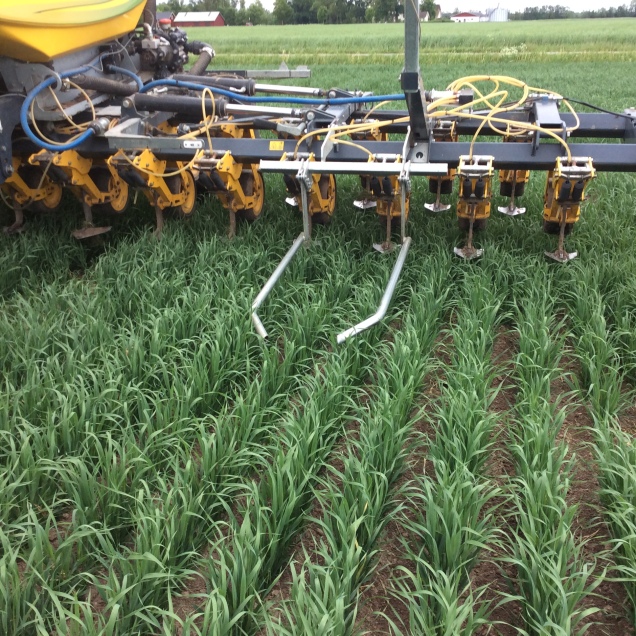
The divider on the front splits the rows so the camera can see better when the crop gets taller. This crop was drilled by this machine and hoed by this machine and fertilised by this machine, as you can see looks excellent. The hoe covers 75% of the field so will kill 75% of the weeds (kind of). More control than you get from Atlantis on Blackgrass. The great thing about this machine is while you are hoeing you can place solid or liquid fertiliser in the ground and you can also seed another crop at the same time. The camera has the ability to shift the machine 25cms sideways (12.5cms either side). It needs a 2cm safe area so it doesn’t hoe the crop.
After lunch I went around the farm with Lars. On the farm he grows Winter Wheat, Spelt Wheat, WOSR, grass seed, Spring Oats, white clover and Spring beans. Lars also does lots of trials on the farm to try out new ideas. One trial was on trying not to plough ( which is the norm)
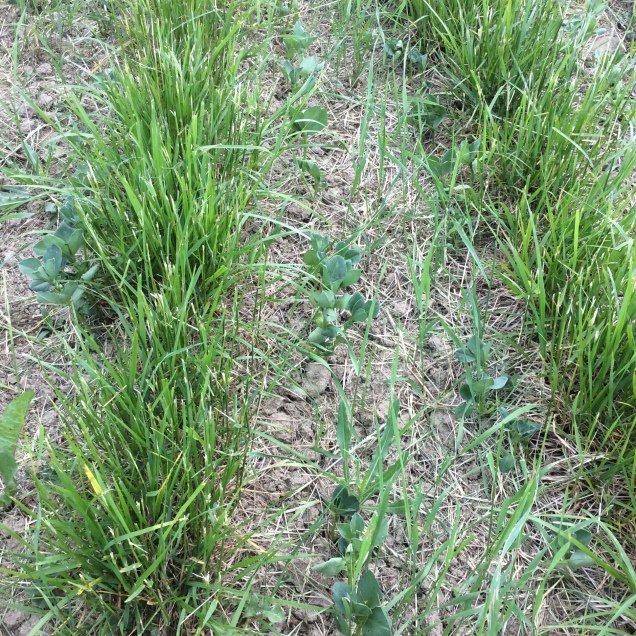
Above is Spring beans drilled between the 3 yr grass seed stand. This is the sixth year. The first year it was winter wheat which was then undersown with WOSR and the grass. Then the next year they harvested the OSR with the grass growing in the bottom, followed by 3yrs grass seed, and now beans, genius! The beans were a little bit water stressed as it is a dry year and the grass’ large root system was taking the water.
Another trial area was looking at seeding band width and row width.
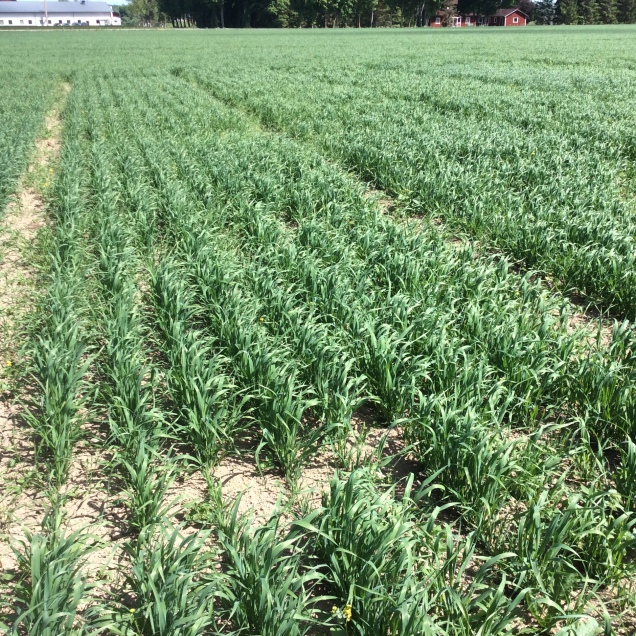
You can change the row width easily on the machine from 25cm to 33cm to 50cm. Lars thinks at the moment the wide row spacing and wide band width is best. Most weeds come in the band so he wants to seed a wider band of crop to compete with the weeds in the row and then hoe out the outside of the band the first time they go through.
After the crop tour we met a group of farm managers from around the world. A Danish farming company had bought all their managers together and were visiting Lars.
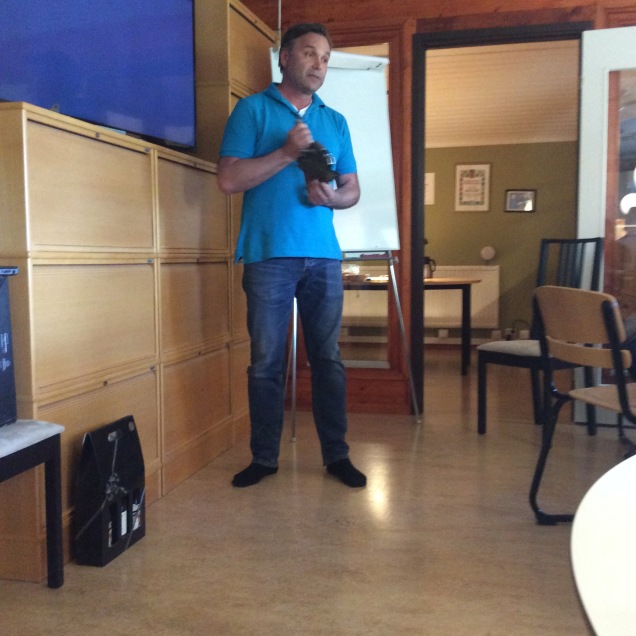
Lars explained to them and me all the different coulter options there are and what the machine can do (there are many!) I had a really great time with Lars and Johan and came away with a much better understanding of the machine and its potential. They are constantly adding more options and are getting more enquiries from conventional and no till farmers and have exciting developments to cater for these new customers. In a modern farming world where we have to produce more crops with less artificial inputs, I think the System Cameleon has an exciting future and Lars and the team are going to be very busy!!
Today I met with Erik Steen Jensen and Georg Carlsson at the Swedish University for Agricultural Science.
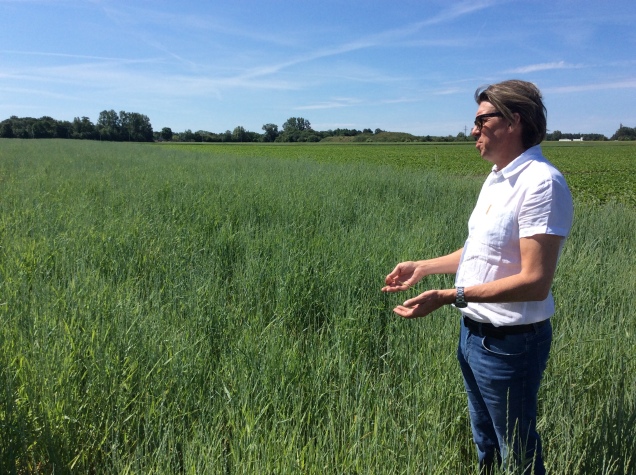
Erik had been recommended to me by Josef. He has had experience with intercropping since the 1980’s and so was someone key for me to meet. There are various trials going on at the moment and the first ones we looked at were in the LEGATO project which is looking at legumes.
Here they had mixes of different varieties of peas and beans in different proportions with different cereals. There were many combinations so I will only show a few. They are looking total yield, standing ability, shading and competition with weeds.
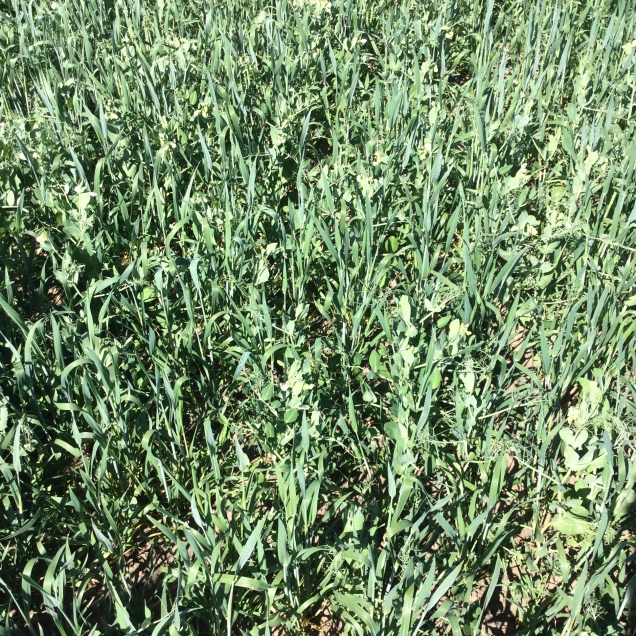
Above is wheat with both leafed and semi leafless peas at 50:25:25 seed rates
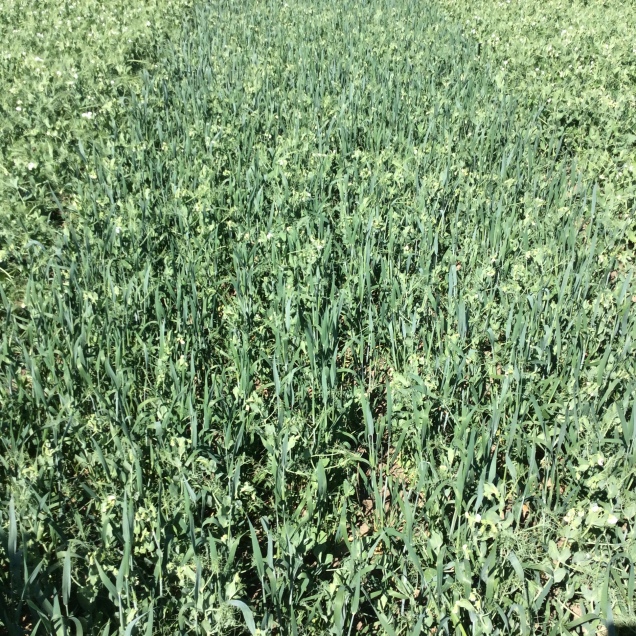
Above is wheat at 50% seed rate and semi leafless at 100%
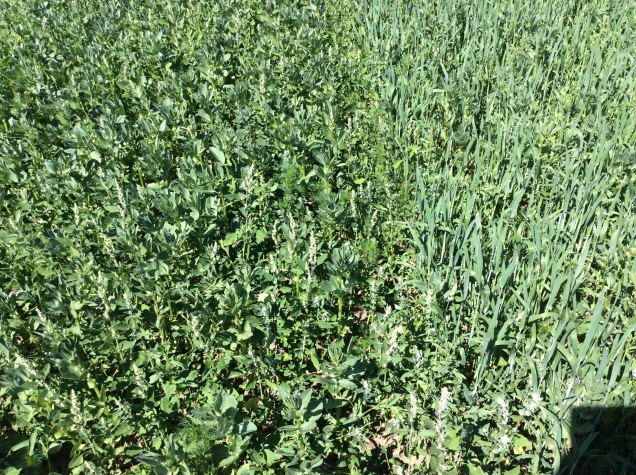
Above there was a problem with fat hen. Interestingly there was less weeds in the wheat bean intercrop compared to the bean sole crop.
They are also looking at mixing in perennial legumes too
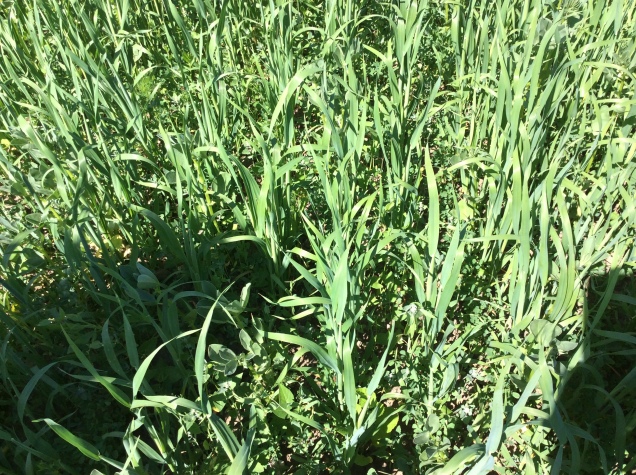
Above is wheat, bean and Lucerne. They get better establishment of the Lucerne when in a mix and Lucerne competes with the weeds and fixes N.

Above is bean/ oats and red clover. Red clover is less competitive than Lucerne apparently. Today we also had a new intern touring around with us. She is from France and is here to work in the trials with Erik and Georg and also learn English, a big day for her too!
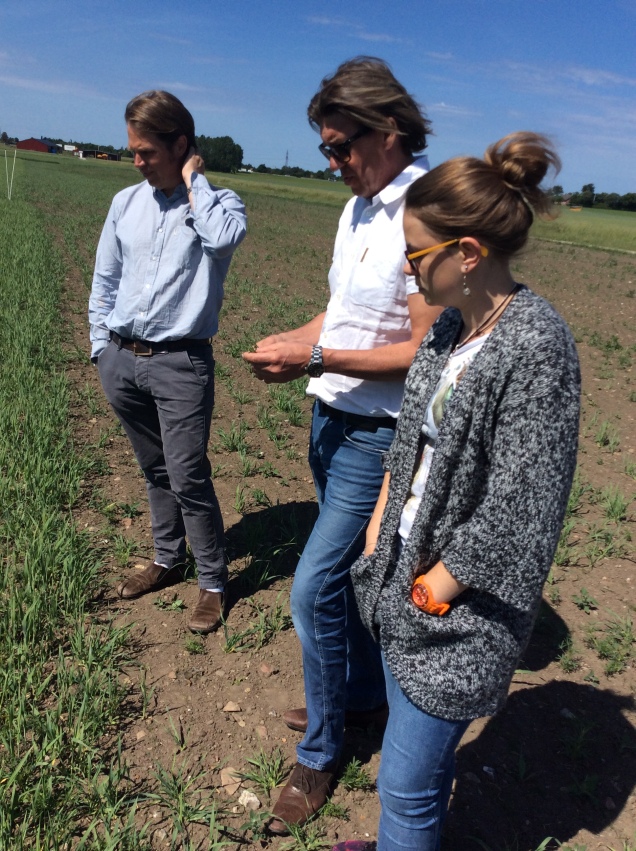
The next project we looked at is a new long term project called SAFE. It is looking at four different cropping systems and measuring various parameters. The first system is the normal conventional system from the area which is Winter wheat, sugar beet, WOSR and Spring barley. The second system is an organic system growing eight crops. The third system is with Kernza (perennial wheat) and the fourth system is Agroforestry with the normal organic rotation.
They first grew the Perennial wheat last year
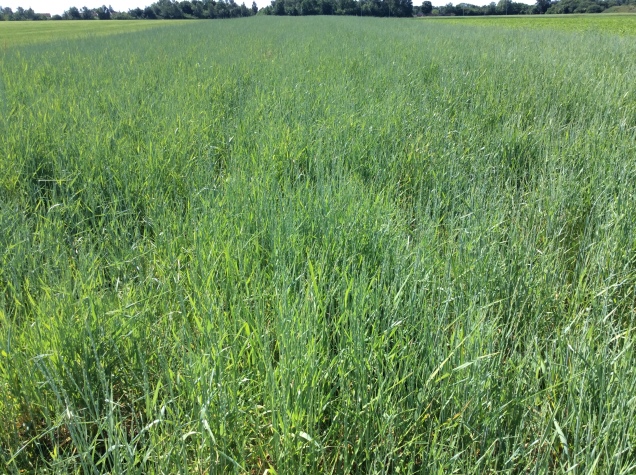
The wheat is not commercialised yet and only yielded 0.8t/ha of wheat last year. They are wanting to trial it so they can understand the effect it has on soils, ecosystems and the environment. They are also wanting to intercrop with it:
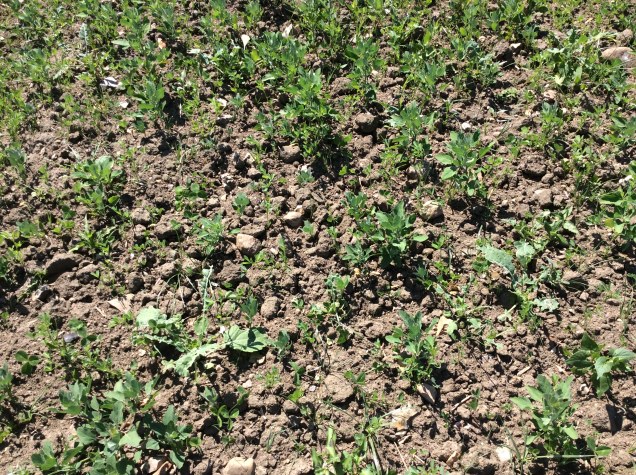
Above is newly planted Kernza with Lucerne
The last project we saw was FIOL (Focus on intercropping on organic legumes) This is part of the same project I saw in Joel’s field and is led in conjunction with local organic farmers who give suggestions and also trial themselves. Again there were many different combinations. Below are a few:

Above is peas and lupins. This was a suggestion by a farmer as it would be a good animal feed and reduce risks at harvest. The lupins are determinate and so harvest earlier than the indeterminate normal lupins.
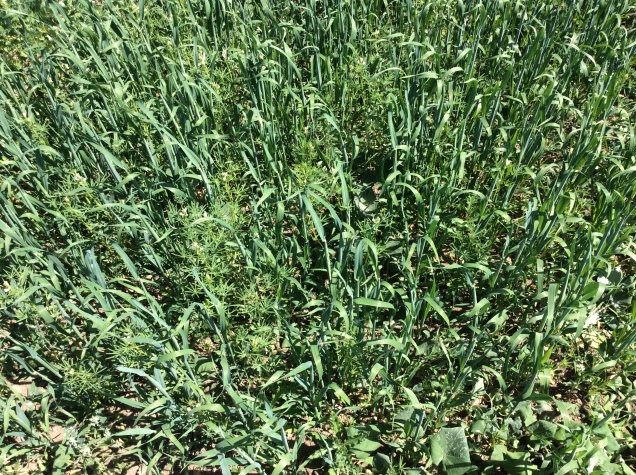
Above is oat and lupin. Lupins are strong competitors for soil N and water and so may not be a great intercrop with cereals.
I had a fabulous day and saw and learnt a huge amount. They really are doing some great work here at SLU.
I was very fortunate that Joel Mansson, another Twitter friend lived very close to Josef and they know each other. So later in the afternoon we went to look at Joel’s farm

Joel has 125 organic hectares and 120ha conventional. On the conventional they grow W Wheat, Sugar Beet and WOSR. On the organic they grow lots of crops including vegetables, which Joel has started this recently. We are standing in organic oats and lentils, which looked excellent. Lentils are the main crop and the oats are a trellis to stop the lentils lodging.
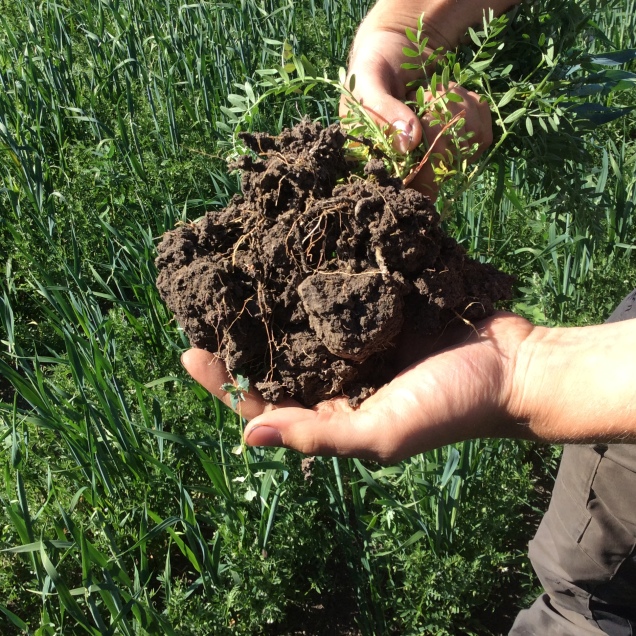
The lentils had plenty of nodules and a good root system

In the middle of one of Joel’ organic pea fields he had some trial plots for intercropping which is done in conjunction with Georg Carlsson at SLU. It is a program where they put plots on ten farmers fields so they can see how they work themselves and also gives Georg good feedback and farmer involvement.
In the plots were:
peas/lupin
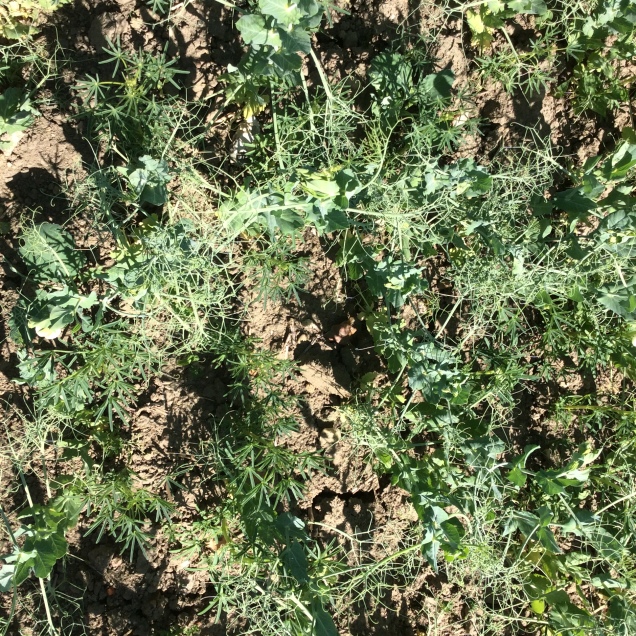
Peas/barley

Barley/Lupins

Lupin/oats

Also lentil plus oats which Joel has a field off. He also tried oats/peas last year and where he had oats he had a lot less lodging in the peas
Joel’s organic winter wheat yields between 5-6t/ha. On the wheat he adds organic fertiliser with the Chameleon and also chicken manure. He believes he can increase his yield if he gets fertiliser on the wheat earlier and is looking to build a machine to inject liquid sow manure into the wheat.
Like Josef, Joel is always trying something different. Below he planted some vetch in the autumn. Then he planted Spring Barley into the vetch direct. He was hoping rolling the vetch would kill it and the barley grow through. The problem is that the ideal time for rolling is at flowering , which is now and this is too late as the vetch has smothered the barley.
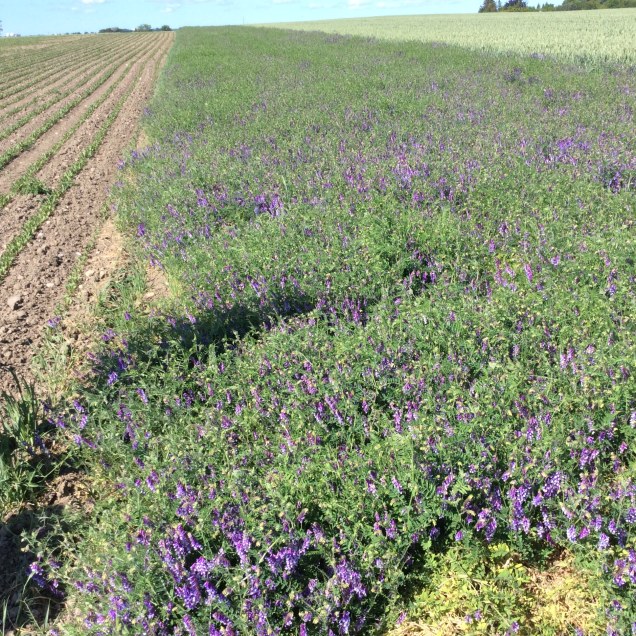
He will plant red beet into this later. It should provide a lot of nitrogen.

He also grows fescue for seed and Spring beans organically
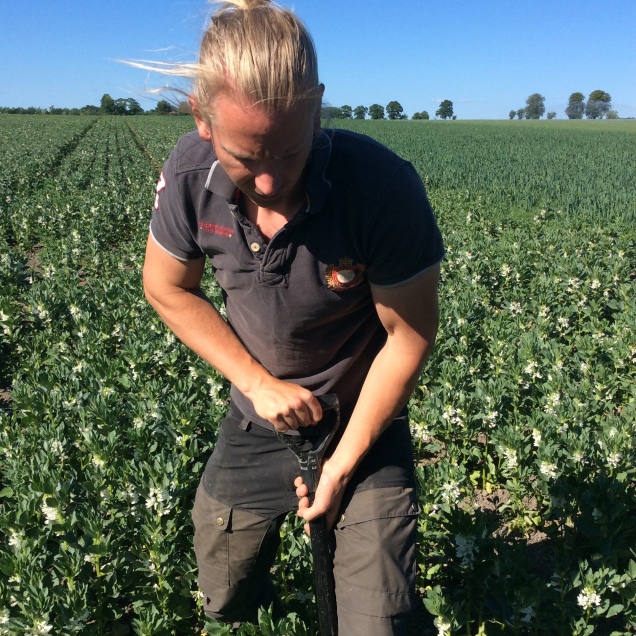
His organic linseed looked great
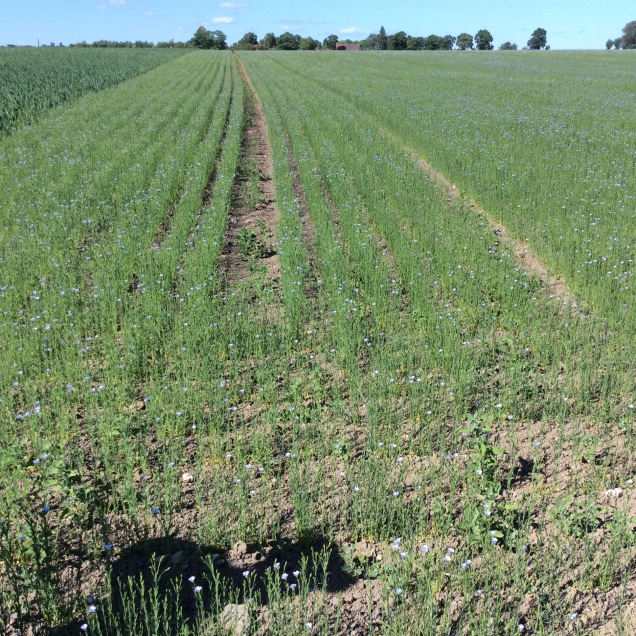
We then moved onto look at his organic vegetables which Joel has started recently. I think last year was his first year. He grows lettuce, squash, celeriac, red beet, potatoes and probably others I have forgotten. A fascinating trial he had done this year was growing lettuce and squash direct into his white clover crop

He rotavated the strips twice and transplanted straight into the strips. The idea is the clover would be a weed mulch, reduce soil erosion and provide N. Interestingly this lettuce looked better than his tilled monocrop lettuce. A great trial.
Joel is very wise for his young age and is very innovative. It was fascinating to have a look around his farm. Thank you Joel.
So today, as all days in Josef’s working life, we started with a crop tour of the farm in a helicopter.
Sweden being a highly developed country allows them to highly subsidise farmers for Cover crops, organic farming and helicopters. Josef uses his helicopter to keep and eye on his spray operators and tractor drivers and if they stray off his 9m CTF tracks they will get the sack immediately by text from the helicopter! He can also see how well the glyphosate is working on his organic land.
Obviously most of the above is not true but we did get an unexpected helicopter ride this morning. Quite normal for Nuffield!
Josef manages a farm in the South of Sweden. He has a very interesting operation as he has 565ha conventional farm which grows Winter Wheat, Sugar Beet, Spring Barley and Winter Oilseed Rape but he also has 315ha of organic land which grows Peas, Spring Oats, White clover, Fescue and Winter Oilseed Rape. Josef is very keen on soil health and tries to improve the farms soils whenever possible, this is in the conventional and organic side of the farm and these complement each other. The organic sector is growing fast and is supported by the government here in Sweden. Every farmer gets paid the Basic Payment for each hectare of £180/ha. If you grow a Cover crop (no legumes) which you kill before the 20th of October , you get £110/ha. If you keep the cover crop until January you get £170/ha. If you are organic you get an additional £150/ha. If you grow organic vegetables you get £500/ha. So you can see cover crops and organic farming are pushed by the government. This is why Josef started to convert parts of the farm 3 years ago, as he could se an added value growing market.
After our helicopter ride we went to look around the crops (by car).
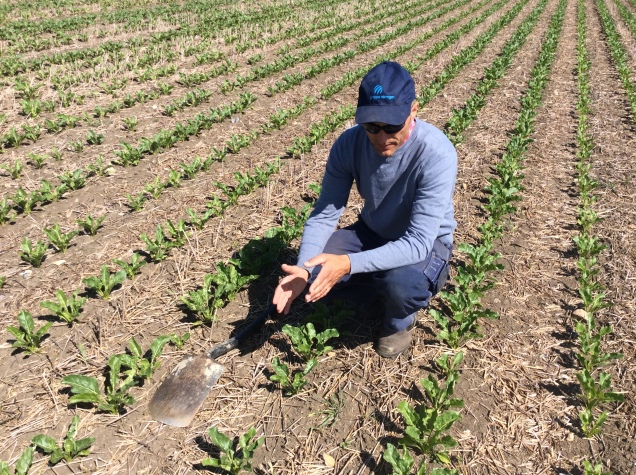
We first looked at Josef’s strip till sugar beet. He was the first to do this around here and some others are now starting to follow. Josef likes strip till beet as the land can hold the harvester in the autumn and the harvester does not make a mess. This means he can get a crop planted straight into the sugar beet stubble. This field was last year winter wheat which was followed by a rye cover crop. Josef then made the strips in the autumn when he adds P and K at the same time. The beet is then drilled into the cover crop and ready made strip. For next year Josef wants to plant a cover crop such as field beans in the strip in the autumn. This will improve soil structure and hopefully fix him some nitrogen.
Afterwards we looked as his conventional winter wheat. This area normally gets 650-700mm of rain but this year May has been very hot and dry. This means the crops are running out of water fast and are coming into head very early. The wheat is flowering the same as home but here we are a couple of hundred miles further north. Normally the wheat would be at least a couple of weeks behind. This crop will be followed by a cover crop of Rye and then put into Spring beans.
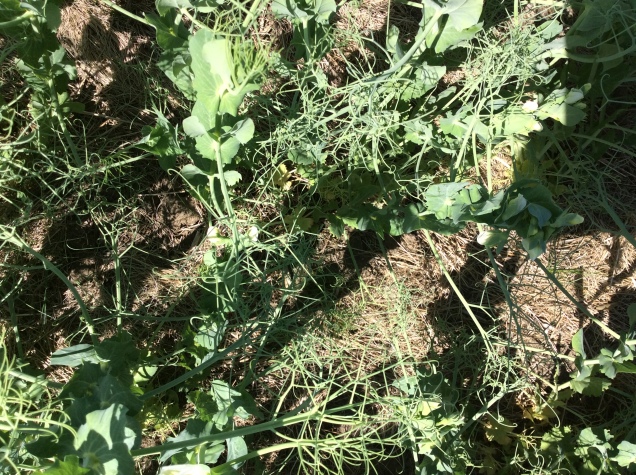
The next crop was organic peas for seed drilled into conventional fescue. This is first year organic so the fescue was sprayed off and then the peas were planted. There were very few weeds, the fescue residue made a very good weed mulch. The peas looked excellent. This will be a radish and oat cover crop followed by spring wheat for seed next year.

Next a great 3rd year organic Spring oat crop that had been hoed with the Chameleon. Very clean and healthy, just a bit thirsty!

Next we saw organic white clover for seed. This was undersown into Spring Barley with the Chameleon last year and will be seed for 2-3 years, then followed by organic WOSR. The clover leaves a lot of nitrogen for the WOSR. The clover was grazed recently, Josef has a Joint Venture with a sheep farmer and finds the sheep very useful in organic farming especially for weed control. Bees are also very important for white clover. They are the biggest return on investment in this crop. The clover will be cut by the double knife four days before harvest.
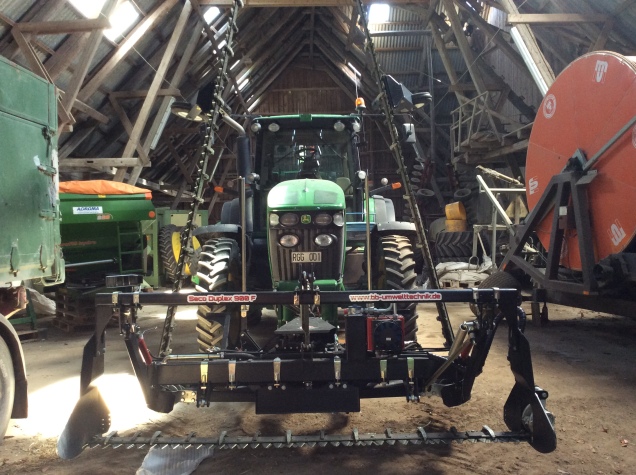
The double knife is above. This is also used for weed control. It is 9m wide and you can drive very fast. Josef is also now a distributor. Then he will harvest the clover with his stripper header.

Above is organic fescue for seed. He will use the residue in his straw burner.
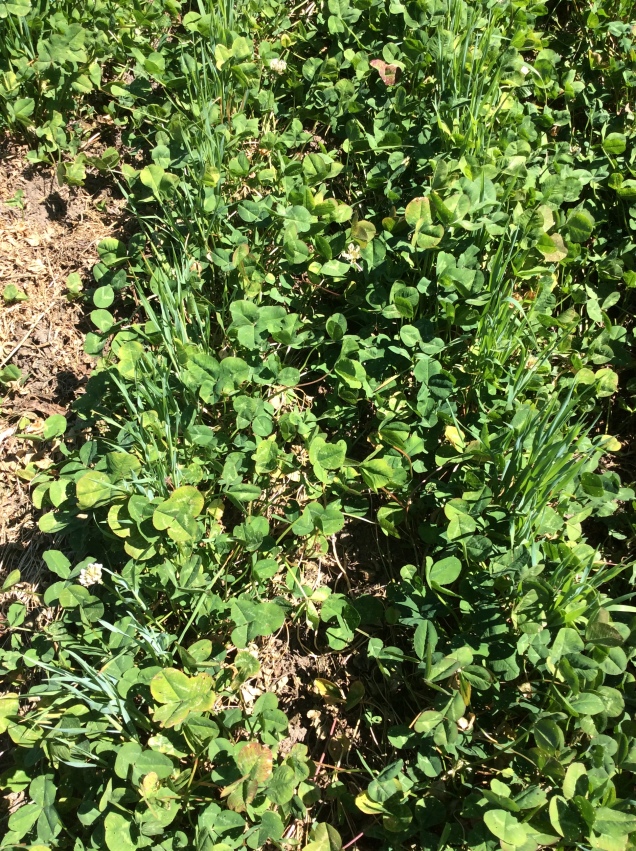
Josef is always trying something new. Above is a trial in organic spring oats where he drilled directly into the white clover. He was hoping the clover would suppress weeds and give him a very clean oat crop with no need to inter-row hoe. Unfortunately the clover has competed with the oats and reduced their growth.
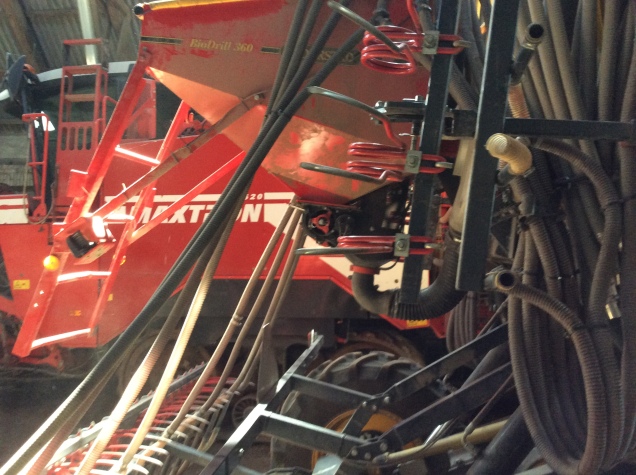
Josef is the kind of farmer who will buy a machine then spend the winter cutting it up, welding it back together and adding bits. He uses the System Chameleon from Gothia Redskap to drill and hoe his crops. He has changed the seed hopper into a fertiliser hopper, added a front seed tank to the tractor, added a bio-drill to the back of his drill for small seeds and slug pellets and also added discs in front of the coulters for when drilling into residue!

Josef is a real innovator and forward thinking farmer and has also been a great host looking after me for two nights and helping organise my few days in Sweden. Thank you Josef, see you again soon.
The second visit of my UK Nuffield mini trip was to see John Pawsey
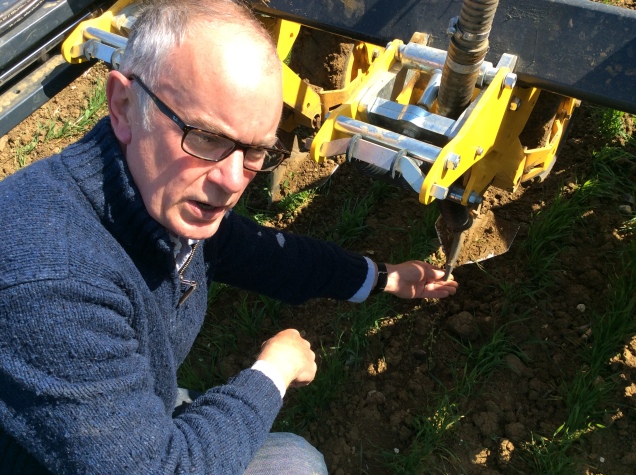
John farms about 3500 acres organically. He converted to organic in 1999 and grows Winter wheat, Spring Oats, winter beans and Spring Barley undersown with a 2 year ley which he now grazes with sheep, a new edition to the farm this year. The other new edition to John’s farm, the System Cameleon, is one of the reasons I wanted to see John.
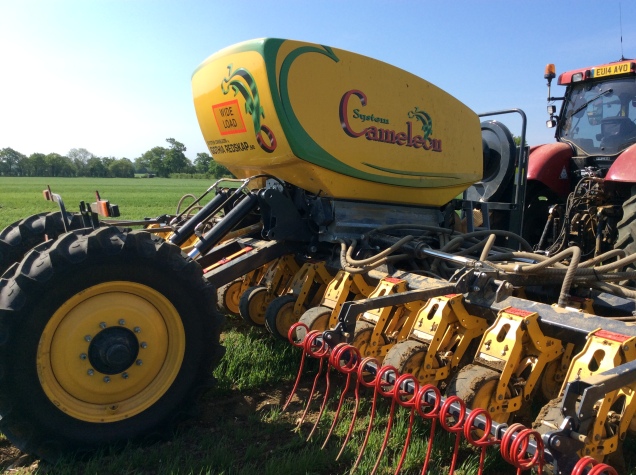
This is the first such machine to be imported into the UK. What makes it unique is that it is a drill and also a inter row hoe. John runs an 8.8m CTF which fits the Cameleon in perfectly. When I got there the machine was busy hoeing

Above is the coulter that drills and hoes. It drills in 25cm rows and the hoe covers 80% of the ground

It really is an impressive machine and does a very accurate job of hoeing. John bought it for a couple of reasons. Firstly as a drill it has a consistent seeding depth, unlike his horsch. This means that when he blind weeds he doesn’t pull out the shallow seeded plants. Also as a hoe it manages to enter the ground in any condition due to the tungsten tip unlike the Garford. As it is so accurate as a hoe it also means it opens up many opportunities for undersowing consistently, intercropping, relay cropping etc.
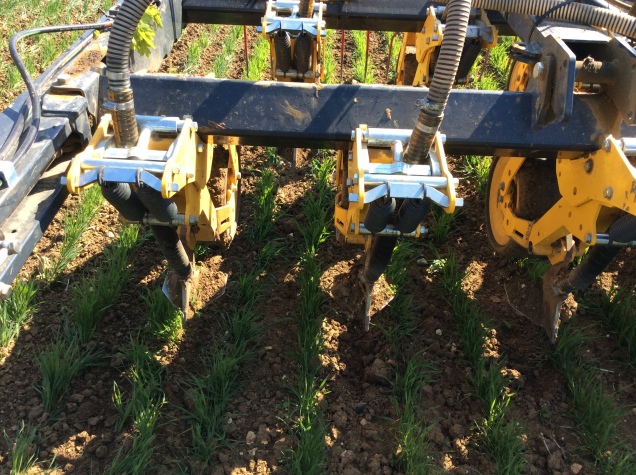
John has become the distributor for the System Cameleon in the UK. If I was ever to convert to organic (no plans😀) this would be the first bit of equipment I would buy.
On John’s farm he is also hosting a field lab which is looking at Black Grass control in cereals through sheep grazing

Above at the top and bottom of the picture has been grazed at GS30-31 by sheep and the middle has not. As can be seen the middle had a lot of BG in head and looks worse than the other. From a quick inspection it seems a success but it looks like the BG in the grazed area is just delayed not killed. They were doing plant counts the day I was there so the results are not known yet. Whether the delayed grass BG produced less seed, I am not sure.
John’s other recent addition to the farm is a flock of New Zealand Romney sheep. These have been introduced to make use of the 2yr leys in the rotation, aid soil health and add diversity to the farm
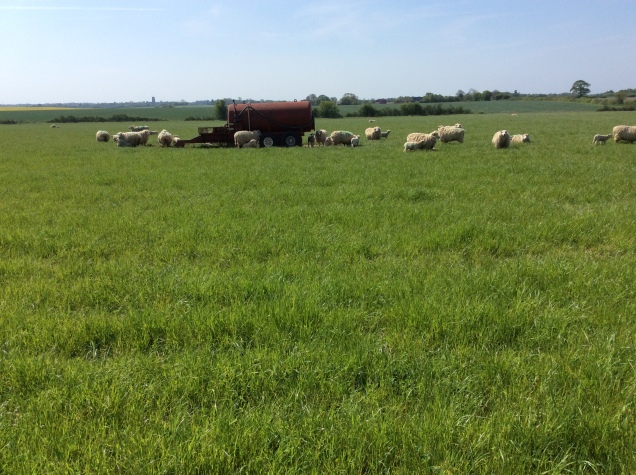
I really enjoyed my morning with John. He is someone who is always looking at ways to improve and is not afraid to try something different. I was really impressed with the farm and the crops. Thank you John.
It’s been over three months since my last post. Nuffield travels have been put on hold until spring work had been completed on the farm. We are a bit quieter now with everything planted so I took the opportunity to make a couple of visits in the UK. My first visit was to Stephen Briggs.
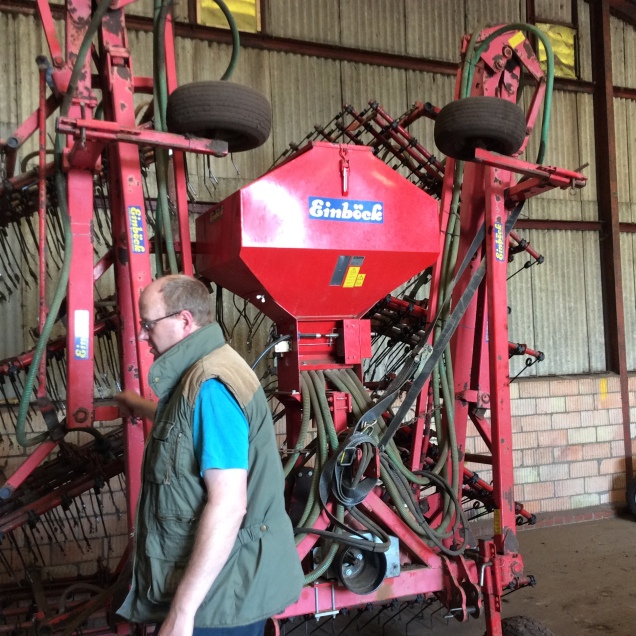
Stephen is a 2011 UK Nuffield ( and also didn’t realise I was taking a photo, not my best shot!). He did his Scholarship on Agroforestry, which is growing trees and annual crops and/or livestock together. Stephen’s home farm is 250 acres and is a council farm. Stephen is a first generation farmer and spent a while trying to get a tenancy and eventually landed Whitehall farm. As the farm is only 250 acres he felt he had to do something different to make it viable, add value and add income streams. This meant converting to organic and 6 1/2 years ago planting apples trees on 52 ha of his arable fields
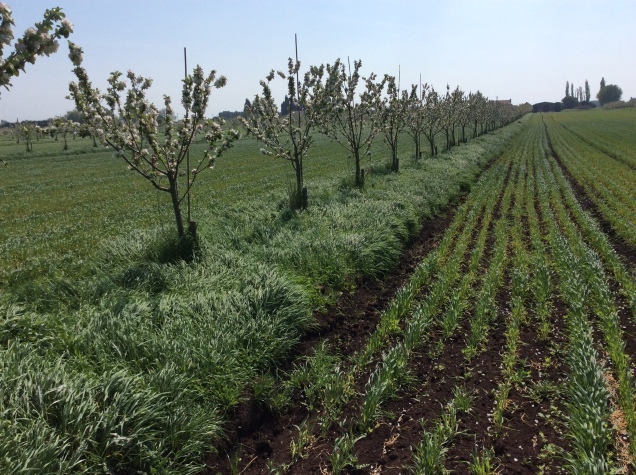
The trees are 13 different varieties of which around half are heritage varieties. They are planted on 3m strips of pollen and nectar mix which is in HLS. The apples are currently used to make apple juice. They receive no inputs apart from pruning. Last year he grew 25t of apples and hopes this yield keeps improving as the trees matures. Currently Stephen thinks he gets 10% extra produce from the farm compared to arable cropping alone and this should keep increasing
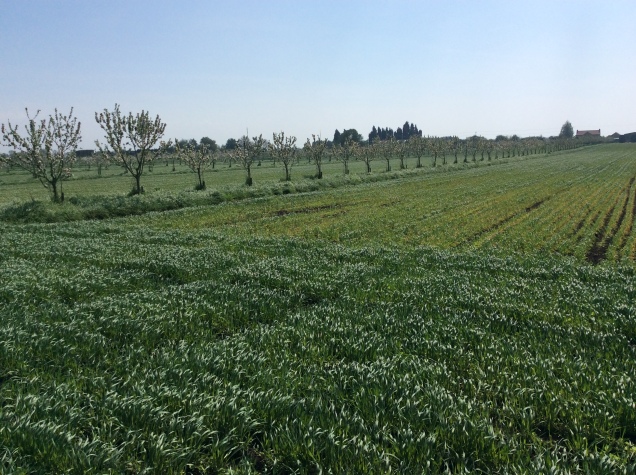
There is 24m of arable crops between the trees. This fits well with his machinery sizes. He is on a 6m CTF including a Tyne drill:

A camera guided Garford inter row hoe:

Stephen soil is incredible:
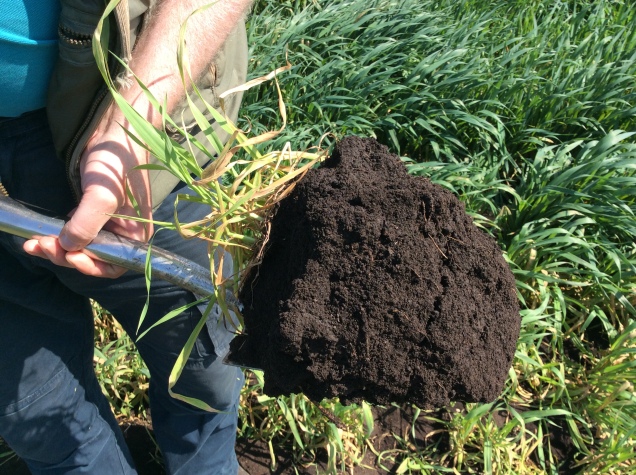
It has Soil Organic Matter of 23% and releases about 150kg/N per ha. It has a couple of downfalls though: it is very prone to wind erosion and due to root crops being grown intensively before, it is now structureless. Stephen hopes the trees will help solve both those issues.
In his crop rotation he grows oats and wheat. Sometimes he also grows vegeltables such as broccoli and beetroot. His crops looked very clean and healthy. Below are oats:
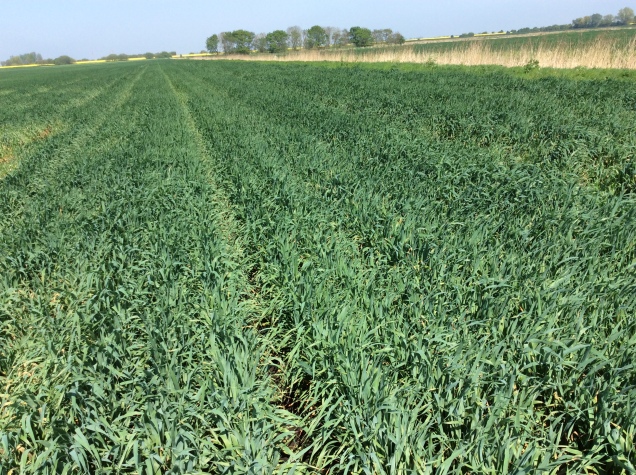
Not satisfied with just Agroforestry, Stephen is hoping to build a farm shop and education centre soon. In his spare time he also consults for other organic farmers and also found time to write a book. I had a very interesting afternoon with Stephen and his set up makes you think of the possibilities at home.
Stephen thank you for your time and good luck!